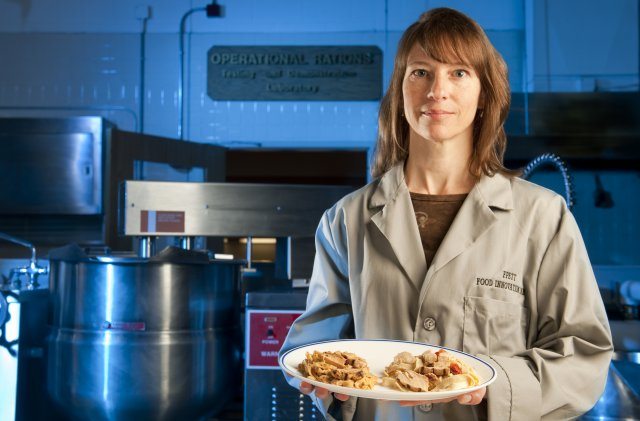Virtually every kitchen in America has at least one, and pretty much everyone knows how to use the technology to at least cook a bag of popcorn.
Right, it’s the microwave oven, which debuted around the middle of the last century and long ago lost its uniqueness.
So why are the folks at the Natick Soldier Research, Development and Engineering Center’s Department of Defense Combat Feeding Directorate charged up these days about microwave technology? Well, it might soon revolutionize what Soldiers eat on the battlefield.
To be fair, this isn’t your grandmother’s microwave oven. Instead, the technology involves large processors doing microwave sterilization of foods that can be included in meals, ready to eat. That process produces low-acid food items that are shelf stable, look and taste better and are nutritionally superior for Soldiers.
“The microwave-sterilization process is fairly new in the U.S.,” said Lauren Oleksyk, team leader of the Food Processing, Engineering and Technology Team at CFD. “Over the last 10 years, this technology has really advanced in terms of food sterilization. Prior to that, there really has been no change in the way low-acid foods are processed.”
“Shelf-stable foods like the MRE entrees are processed by retort thermosterilization. This canning process goes back to the Napoleonic era over 200 years ago. The FDA approval of microwave sterilization for low-acid foods within the last three years is really the first revolutionary change in food sterilization in the last 200 years.”
Welcome to the 21st century, where microwave sterilization has made many things possible for the MRE, even the return of macaroni and cheese and Mexican macaroni and cheese entrees.
“Both of them have been dropped from MREs,” said Tom Yang, CFD’s project officer for microwave sterilization. “Microwave sterilization can really revive these kind of dishes. If you retort macaroni and cheese, the detrimental effects of the retort process result in a product that is like a lump — a rubbery, tasteless lump.”
“If you use the microwave process on mac and cheese, it’s going to be very bright yellow. It has a pleasant cheese aroma. So it’s a big difference.”
“It tastes like it was freshly prepared, but it is not,” said Oleksyk of microwave-sterilized foods. “It’s fully sterilized, and it’s shelf stable.”
As Yang pointed out, the existing retort sterilization process to make foods safe and shelf stable can stretch to three hours, while microwave sterilization takes about eight minutes.
“Why the food tastes bad is it’s been in the retort for so long,” Yang said. “We are destroying not only the quality but also the nutrients — everything.”
Yang began looking into microwave sterilization two decades ago, when he discovered that a company in Belgium was doing it.
“I saw that, and my antenna shot up,” Yang recalled. “I got everybody here (at Natick) excited. It’s a good product, but I ran into a stone wall.”
The foreign company had no intention of entering the U.S. market. Fortunately, however, Yang found that Washington State University also was pursuing the technology. He began working with the school and a handful of industry partners.
“We’re not doing this all alone at Natick,” Oleksyk said. “This involves a big consortium partnership with industry and academia and Natick.”
After years of work, the consortium sought regulatory approval from the FDA for mashed potatoes — a simple, homogeneous food. It was granted in 2009.
“That was our very first trial product,” Oleksyk said. “Potatoes were a fairly simple product to start with.”
The consortium then moved on to something more complex — salmon and Alfredo sauce.
“We’re thinking this is one way we can better process seafood,” Oleksyk said. “Seafood is very limited in rations because it’s hard to process, but it can also be a great source of healthy Omega-3 acids.”
The FDA approved microwave sterilization of that product in December 2010. Next up was a meat dish, which would require U.S. Department of Agriculture approval. The consortium cleared that hurdle last month with chicken and dumplings.
That USDA approval clears the way for future microwave sterilization of all meat-based products, according to Oleksyk.
“That approval opens the door for all kinds of casserole-type and whole-muscle foods containing meat,” Oleksyk said. “Most MRE entrees contain meat. It is a big source of protein in rations.”
Consortium industry members include Food Chain Safety, Hormel, Nestle, Rexam, Bush Brothers, General Mills, PrintPack, Ocean Beauty Seafoods, Pepsi-FritoLay, Del Monte, and current ration vendors AmeriQual and Wornick Foods.
“Their goal in the last couple of years has been to commercialize microwave-sterilization technology,” Oleksyk said. “I do think you’re going to see commercial products that are microwave sterilized fairly soon. The commercial market does not have the three-year shelf life constraint that military rations have.”
The approved foods are going through in-house sensory panels and storage studies at Natick, and they soon will undergo field testing by Soldiers. Oleksyk projected that the first microwave-sterilized foods could be approved for ration menus as early as next year.
“It’s going to bring great quality food to the war fighters,” Oleksyk said. “The main challenge for us right now is the package.
“You can’t have foil in a microwave, and foil packaging contributes to the long ration shelf life. So we are examining pouches that don’t have foil but still provide the barrier and protection our rations require.”
Oleksyk said she expected microwave sterilization to also save money.
“Our industry partners are analyzing the cost savings now,” Oleksyk said. “They do think there will be a cost savings in the throughput, because you have an eight-minute microwave process versus an hour-plus retort process.”
In the final analysis, it’s all about giving Soldiers foods that they like and that are better for them.
“We still have a ways to go,” said Yang, “but at this moment, those milestones we have achieved give us a lot of confidence that we are on the right track.”










